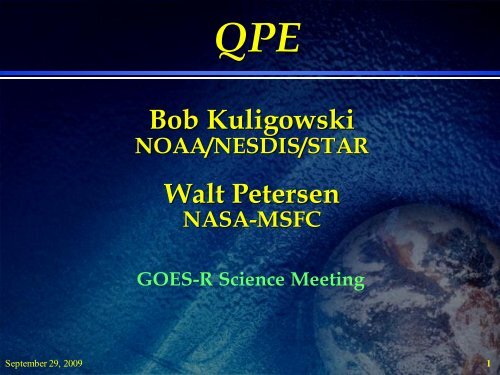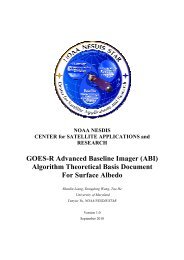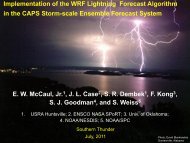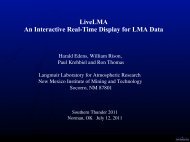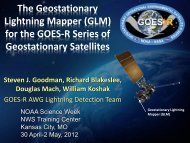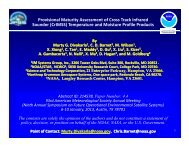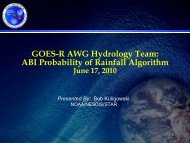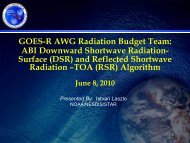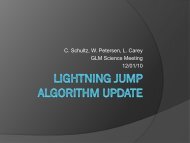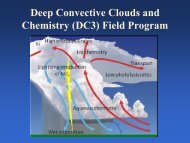SCaMPR Review - GOES-R
SCaMPR Review - GOES-R
SCaMPR Review - GOES-R
You also want an ePaper? Increase the reach of your titles
YUMPU automatically turns print PDFs into web optimized ePapers that Google loves.
QPE<br />
Bob Kuligowski<br />
NOAA/NESDIS/STAR<br />
Walt Petersen<br />
NASA-MSFC<br />
<strong>GOES</strong>-R Science Meeting<br />
September 29, 2009 1
Outline<br />
<strong>SCaMPR</strong> <strong>Review</strong> and Plans<br />
<strong>GOES</strong>-RRR Proposal: Improved MW Retrievals<br />
MSFC QPE Work<br />
Questions / Discussion (all)<br />
September 29, 2009 2
<strong>SCaMPR</strong> <strong>Review</strong><br />
Self-Calibrating Multivariate Precipitation Retrieval<br />
Calibrates IR predictors to MW rain rates<br />
Updates calibration whenever new target data (MW<br />
rain rates) become available<br />
Selects both best predictors and calibration<br />
coefficients; thus, predictors used can change in<br />
time or space<br />
Flexible; can use any inputs or target data<br />
September 29, 2009 3
<strong>SCaMPR</strong> Overview (cont.)<br />
Two calibration steps:<br />
» Rain / no-rain discrimination using discriminant<br />
analysis<br />
» Rain rate using stepwise multiple linear regression<br />
Classification scheme based on BTD’s (ABI only):<br />
» Type 1 (water cloud): T 7.34
Output<br />
Assemble training data set<br />
Calibrate rain rate<br />
retrieval<br />
START<br />
Predictors from<br />
ABI / GLM<br />
Aggregate to spatial resolution<br />
of target data<br />
Target rain rates<br />
Matched nonraining<br />
predictors<br />
and targets<br />
Match non-raining raining target<br />
pixels with corresponding<br />
predictors in space and time<br />
Match raining target pixels with<br />
corresponding predictors in<br />
space and time<br />
Matched raining<br />
predictors and<br />
targets<br />
Calibrate rain detection<br />
algorithm using discriminant<br />
analysis<br />
Create nonlinear transforms of<br />
predictor values<br />
Calibrate rain intensity algorithm<br />
using regression<br />
Subsequent<br />
ABI / GLM data<br />
Apply calibration coefficients to<br />
independent data<br />
END<br />
September 29, 2009 5
<strong>SCaMPR</strong> Plans<br />
Incorporate numerical model moisture fields to<br />
handle hydrometeor evaporation<br />
Correct for orographic effects on rainfall<br />
Incorporate convective life cycle information (i.e.,<br />
changes in rain rate vs. cloud properties during<br />
convective cycle)<br />
Incorporate Lagrangian (cloud-following) Tb changes<br />
Incorporate retrieved cloud microphysics (i.e., cloudtop<br />
particle size, phase)<br />
September 29, 2009 6
Outline<br />
<strong>SCaMPR</strong> <strong>Review</strong> and Plans<br />
<strong>GOES</strong>-RRR Project: Improved MW Retrievals<br />
MSFC QPE Work<br />
Questions / Discussion (all)<br />
September 29, 2009 7
<strong>GOES</strong>-RRR Project Summary<br />
<br />
<br />
Proposal Team: N. Wang, E. Bruning, R. Albrecht,<br />
K. Gopalan, M. Sapiano (UMD/ESSIC); R.<br />
Kuligowski, R. Ferraro (NESDIS/STAR)<br />
Objectives:<br />
(1) To improve microwave (MW)-based precipitation<br />
estimates by connecting the ice-phased microphysics<br />
commonly observed by <strong>GOES</strong>-R lighting and GPM<br />
MW instruments.<br />
(2) To improve the <strong>GOES</strong>-R rain-rate (QPE) algorithm by<br />
using these estimates as input.<br />
September 29, 2009 8
Basic Problem and Approach<br />
Problem:<br />
» Since the <strong>GOES</strong>-R rain-rate algorithm uses MW-derived rain rates<br />
for calibration, errors in the MW rain-rates are reflected in the<br />
<strong>GOES</strong>-R rain rates.<br />
» The MW rain-rate algorithm over land has problems of properly<br />
identifying convective/stratiform rain type, which causes errors in<br />
rain-rate retrievals.<br />
Planned approach:<br />
» Use <strong>GOES</strong>-R GLM lighting data to constrain the MW<br />
convective/stratiform classification and thus reduce the<br />
misclassification of rain type.<br />
» Use the improved MW rain-rates to produce better calibration for<br />
the <strong>GOES</strong>-R rain rate algorithm.<br />
September 29, 2009 9
TMI RR (mm/hr)<br />
TMI CSI<br />
Errors in Current TRMM Algorithm<br />
TRMM PR v.s. TMI rain-rates<br />
TRMM PR v.s. TMI convective ratio<br />
90<br />
1<br />
80<br />
0.9<br />
70<br />
0.8<br />
60<br />
0.7<br />
50<br />
40<br />
30<br />
20<br />
0.6<br />
0.5<br />
0.4<br />
0.3<br />
0.2<br />
10<br />
0.1<br />
0<br />
0 5 10 15 20 25 30 35 40 45 50<br />
PR RR (mm/hr)<br />
0<br />
0 0.1 0.2 0.3 0.4 0.5 0.6 0.7 0.8 0.9 1<br />
PR Conv. ratio<br />
Improved convective/stratiform classification should lead to<br />
more accurate MW rain rate retrievals.<br />
September 29, 2009 10
An example of a MCS<br />
TRMM microwave and lighting sensors as the proxy for <strong>GOES</strong>-R<br />
Potential Improvement to Current<br />
MW Algorithm<br />
TMI 85GHz PCT+ LIS flashes<br />
VIRS 10.8 m + LIS flashes<br />
September 29, 2009 11
Potential Improvement to Current<br />
MW Algorithm<br />
PR rain rates<br />
TMI rain rates<br />
September 29, 2009 12
Outline<br />
<strong>SCaMPR</strong> <strong>Review</strong> and Plans<br />
<strong>GOES</strong>-RRR Proposal: Improved MW Retrievals<br />
MSFC QPE Work<br />
Questions / Discussion (all)<br />
September 29, 2009 13
Lightning Input to <strong>SCaMPR</strong> Flow<br />
Rainfall Rate Start<br />
Lightning<br />
Guidance?<br />
Current algorithm depends strongly on presence<br />
of a “calibrating” PMW estimate<br />
- OK at O(1x1 o ) areas over warm oceans for<br />
emission based methods when integrated over<br />
longer time intervals<br />
- Questionable accuracy over land (much work<br />
to be done prior to/during GPM)<br />
- Questionable application to diagnosing “rate”<br />
at <strong>GOES</strong>-R pixel level.<br />
New<br />
microwave<br />
rain rates<br />
available?<br />
No<br />
Yes<br />
Error<br />
magnified<br />
Errors In<br />
Input ABI data<br />
Compute ABI derived<br />
parameters (e.g., temperature<br />
differences)<br />
Input microwave<br />
rain rates<br />
Aggregate ABI data to<br />
microwave footprints<br />
Match ABI predictors with<br />
microwave footprints<br />
Use discriminant analysis to<br />
find rain detection predictors<br />
and coefficients<br />
Use regression to find rain<br />
rate predictors and<br />
coefficients<br />
Overarching focus: How to use Lightning when it<br />
occurs.<br />
Lightning<br />
Guidance?<br />
Input necessary<br />
ABI data<br />
Determine raining areas<br />
Compute rain rates in raining<br />
areas<br />
Rain detection and<br />
rate predictors and<br />
coefficients<br />
Output<br />
Rainfall Rate End
What kind of guidance?<br />
1) Rainfall Detection and Convective and Stratiform (C/S) Precipitation<br />
• C/S partitioning in most state of the art radar algorithms (problematic for satellite algorithms)<br />
• “Low-hanging fruit”- Lightning is a “rain certain” parameter and by virtue of its origin, facilitates<br />
better C/S partitioning of rain area/volume (Grecu et al., 2000; Morales and Anagnostou, 2003)<br />
• Focus: Presence/amount of lightning for identifying systematic differences (e.g.,<br />
constraints) in cloud-system-wide C/S precipitation behavior<br />
2) Application to Passive microwave (PMW) rainfall retrievals<br />
• Most lightning occurs over land- land focus for QPE application<br />
• PMW rain estimates over land are “iffy”- algorithms empirically driven by assumed icescattering<br />
relationship to rain water content w/some inclusion of weak physics (e.g., GPROF<br />
• Problem: As in the case of IR retrievals, even if the ice is there rainfall is often not coupled to<br />
the ice phase; not even a guarantee it will be useful in “big” rainfall events (e.g., spectacular<br />
failures of satellite QPE in shallow-convective environment floods).<br />
• Focus: Identify specific situations where lightning occurs with systematic PMW bias or<br />
can “nudge” the answer- thus affecting error reduction in the <strong>SCaMPR</strong> calibration
Convective Fract.<br />
Identifying Systematic C/S behavior in TRMM Features<br />
Volume Rain.<br />
Rain Rae (mm/hr)<br />
Convective<br />
Stratiform<br />
Feature area<br />
Feature area<br />
Feature area<br />
When lightning present, clear increase in convective area-fraction, feature rainrate, and<br />
convective rain volume regardless of “feature” area.<br />
Stratiform behavior virtually identical between lightning/non-lightning cases<br />
September 29, 2008 16
Ongoing Work<br />
C/S in N. Alabama Testbed<br />
TRMM PMW: When TMI > ( 1.4 PR RR<br />
5 km<br />
0 o C<br />
JJA Africa<br />
CFAD dBZ<br />
Lightning =<br />
JJA LIS FD (solid)<br />
85 GHz TB v (dash)<br />
TMI< PR<br />
Ground Validation Case Work (To be<br />
done in near future)<br />
• Dual-pol rain map (done) + C/S<br />
partitioning with new GLM Proxy<br />
• Relate C/S and flash behavior over<br />
time integrals and lifecycles, compared<br />
to TRMM “snapshots”.<br />
• Match to <strong>GOES</strong> IR Tb areas (Morales<br />
and Anagnostou approach)<br />
TMI< PR<br />
TRMM Work<br />
TMI >PR<br />
TMI >PR<br />
JJA PR RR (solid)<br />
TMI RR (dash)<br />
• 3-D ASCII features and pixels for the globe<br />
• Identify PMW biases sensitive to lightning<br />
character<br />
• Extend C/S study to global domain<br />
17
<strong>SCaMPR</strong> Plans: Lightning<br />
Provided <strong>SCaMPR</strong> source code and documentation to R.<br />
Albrecht/Petersen for collaborative work<br />
Consider using lightning both as an aid to classification<br />
(i.e., convective vs. stratiform), rain rate prediction, PMW<br />
“nudging”<br />
Current challenges:<br />
» Resolution of GLM is coarser than ABI—how to best<br />
use lightning data without creating an overly smooth<br />
output?<br />
» Difficult to obtain total lightning over a large enough<br />
area and long enough time for reliable <strong>SCaMPR</strong><br />
calibration (GV?)<br />
» Where to insert lightning inputs?<br />
No final answers yet on several of these issues<br />
September 29, 2009 18
FUTURE: A “STRAWMAN FRAMEWORK” FOR <strong>GOES</strong>-R GLM QPE ALGORITHM:<br />
GLM Pixel Lightning +/- X minutes No <strong>SCaMPR</strong><br />
Yes<br />
Cluster w/Pixel information<br />
Location, Cluster history, granularity/eccentricity, Flash extent, Flash rate [FR], D(FR)/Dt<br />
Convective Area Fraction<br />
Growing Mature Decaying<br />
Stratiform Area Fraction<br />
Growing Mature Decaying<br />
Pr(Rain volume/Rate Class |Character)*<br />
Disaggregate (downscale)<br />
* Includes assessment<br />
of possible PMW bias<br />
<strong>SCaMPR</strong> Rain Type<br />
<strong>SCaMPR</strong> GForecast<br />
Petersen, 9/29/2009
Questions /<br />
Discussion?<br />
September 29, 2009 20


